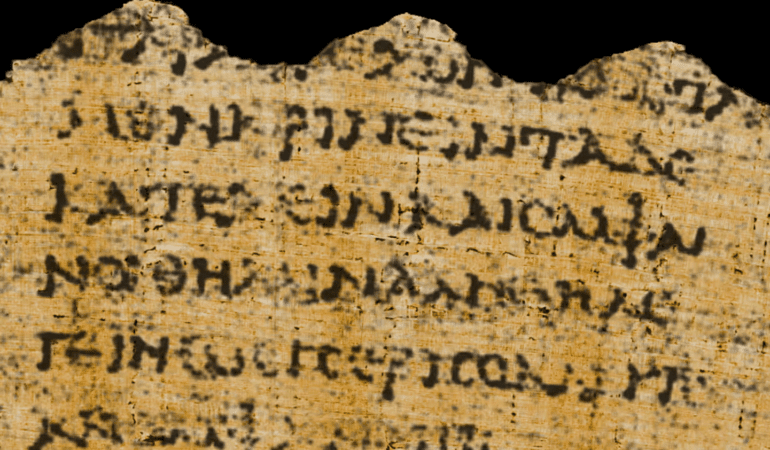TL;DR:
- Researchers employ AI to decipher charred scrolls buried during Mount Vesuvius’ AD79 eruption.
- A $1 million competition, the Vesuvius Challenge, leads to the breakthrough.
- A team of computer-savvy students wins the $700,000 grand prize.
- The scrolls offer insights into Greek philosophy and sources of pleasure.
- AI algorithms are used to virtually unwrap CT scans and detect ink presence.
- Potential applications include deciphering more Herculaneum scrolls and Egyptian mummy papyri.
- The challenge continues to aim for 85% scroll decryption and automation improvements.
Main AI News:
In the realm of historical treasures, a groundbreaking achievement has sent ripples of excitement through the academic world. A charred scroll, entombed in the cataclysmic eruption of Mount Vesuvius almost two millennia ago, has finally revealed its long-hidden secrets, thanks to the marvels of artificial intelligence. This remarkable feat has ignited a new era of understanding for scholars of antiquity.
These ancient scrolls, believed to have been housed in the opulent Roman villa of Herculaneum, were reduced to ashes when the town met its fiery demise alongside Pompeii in AD79. Although over a thousand whole or partial scrolls were unearthed during 18th-century excavations, their blackened ink and fragile state kept their contents tantalizingly out of reach.
The turning point in deciphering this ancient material came in the form of the Vesuvius Challenge, a $1 million competition initiated in 2023 by Brent Seales, a computer scientist from the University of Kentucky, with backing from Silicon Valley. The challenge revolved around extracting text from high-resolution CT scans of a scroll obtained at Diamond, the UK’s national synchrotron facility in Oxfordshire.
Nat Friedman, a prominent US tech executive and a founding sponsor of the challenge, recently announced the triumphant team behind this monumental feat. Comprising three talented computer-savvy students – Youssef Nader in Germany, Luke Farritor in the US, and Julian Schilliger in Switzerland – they clinched the grand prize of $700,000 (£554,000) after successfully deciphering over 2,000 Greek letters from the scroll.
Papyrologists, who have long grappled with the enigma of these charred scrolls, are astounded by this breakthrough. “This is a complete gamechanger,” declared Robert Fowler, emeritus professor of Greek at Bristol University and chair of the Herculaneum Society. “There are hundreds of these scrolls waiting to be read.”
Dr. Federica Nicolardi, a papyrologist at the University of Naples Federico II, hailed this achievement as the dawn of a revolution in Herculaneum papyrology and Greek philosophy. She proclaimed, “It is the only library to come to us from ancient Roman times.“
Brent Seales, the mastermind behind the AI-driven approach, is now setting his sights on developing a portable CT scanner for imaging scrolls without disrupting their collections. In October, Luke Farritor had already made waves by identifying the ancient Greek word for “purple” within the scroll, and he later joined forces with Youssef Nader and Julian Schilliger, who played a crucial role with an algorithm for unwrapping CT images.
This journey of discovery has been a whirlwind for the winning team, with Youssef remarking, “It’s been an incredibly rewarding journey. The adrenaline rush is what kept us going. It was insane.” Their efforts have offered scholars their first authentic glimpse into the scroll’s contents, believed to be the work of Philodemus, delving into the sources of pleasure, including music, food – notably capers – and the nature of pleasure derived from various combinations.
With the technology’s potential, not only are there hundreds of scrolls waiting to be explored at Herculaneum, but similar techniques could be applied to papyrus wrapped around Egyptian mummies. This could unlock a treasure trove of insights into the daily lives of ancient Egyptians, ranging from letters and property deeds to mundane lists and tax records.
As the Vesuvius Challenge continues into the new year, the goal remains to read 85% of the scroll and establish the groundwork for deciphering all previously excavated scrolls. The aim is to fully automate the process of tracing the papyrus’s surface within each scroll and enhance ink detection on the most damaged sections.
Friedman aptly sums up this extraordinary endeavor, “When we launched this less than a year ago, I honestly wasn’t sure it’d work. This has been pure joy. It’s magical what happened, it couldn’t have been scripted better.” The fusion of technology, determination, and a dash of serendipity has indeed unveiled a new chapter in the annals of history.
Conclusion:
The successful use of AI to unlock the secrets of ancient scrolls buried by Mount Vesuvius represents a significant milestone in the fields of archaeology and historical research. This breakthrough not only enriches our understanding of the past but also opens up new avenues for technological applications in preserving and deciphering ancient texts. It highlights the potential for AI to play a pivotal role in uncovering hidden knowledge and could foster increased interest in further archaeological endeavors.

